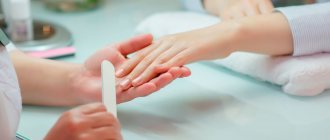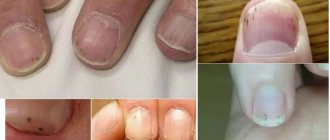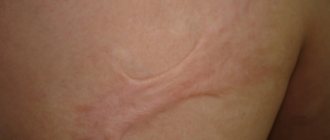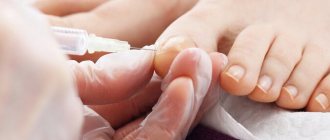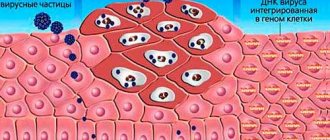Why does the nail lag or fall off the nail bed: main reasons
There are many possible causes of nail plate detachment:
- Long-term treatment with antibiotic drugs. Especially the tetracycline and fluoroquinol series. As a rule, nails return to normal on their own after completing the course of treatment.
- Finger injury (physical or chemical) - this could be a bruise, pinching, or burn from a chemical, solvent, or cleaning agent.
- Skin diseases - eczema, dermatitis, psoriasis, etc.
- Chronic pathologies in the cardiovascular, nervous or digestive systems.
- A state of chronic stress, nutritional or vitamin deficiency as a result of a strict diet.
Most often, toenails fall off for two reasons: foot fungus and mechanical injuries. In order to be able to provide first aid to yourself, it is important to learn to distinguish the symptoms of the disease. Let's look at both options in a little more detail.
How to recognize a fungus?
Foot fungus can be picked up in a bathhouse, sauna, swimming pool, locker room at a fitness center and in any other public place where high humidity and temperature are combined with a lack of fresh air.
In the initial stages, the fungus is practically asymptomatic, but it can be recognized by the following signs:
- severe itching of the fingers and between them;
- pale skin;
- loss of transparency of the nail plate;
- peeling, itching and cracks between the fingers;
- an abundance of hangnails around the nail bed;
- detachment of the nail plate;
- increased sweating and unpleasant odor from the feet, especially noticeable immediately after removing shoes.
If the cause of peeling of the nail plate is a fungus, you must wait until the peeling process is completed and only then begin treatment.
Fungus is a rather unpleasant disease, but it can be easily avoided if you adhere to the following rules:
- Use individual manicure accessories and disinfect them before each new use.
- Get a separate towel for your feet and wash it more often.
- Change socks and tights after each wear.
- Cleanse the skin of your feet daily. When wearing open shoes - twice a day.
- Regularly wash and dry shoes, and also treat the inner surface with an antiseptic spray.
- Avoid trying on shoes on bare feet, especially if someone else has already worn the shoes before you.
- Carefully monitor the cleanliness of the floors in the house and the bathroom in particular.
Nail plate injury - symptoms
There are many everyday ways to damage the nail plate: dropping something heavy, hitting your finger on the corner of furniture, or twisting your leg. You can recognize a nail injury by the following unpleasant symptoms:
- aching and throbbing pain in the finger;
- discomfort when walking;
- redness around the bruise;
- swelling and bruising around the nail plate.
The thumb and little finger are most often injured. Healing on them takes longer than on others due to their location and mobility.
After the pain subsides, the tissue under the nail begins to turn blue. In some cases, the hematoma subsides. In others, it begins to turn black, which indicates that the nail will soon peel off. Often this phenomenon is accompanied by the sensation of a foreign body under the skin.
Causes of toenail falling off
If your nail has fallen off on your toe or hand, the first thing you need to do to fully restore it is to find out the reason for such destruction of the surface. Most often it is associated with problems with the matrix, but there are many factors that can affect the future condition of the legs.
Most often, such damage is associated with exposure to external factors:
- Mechanical damage. The factor occurs most often, especially on the legs, since pinching, severe bruising or fracture of the fingers/toes leads to deformation of the surface and poor circulation;
- Exposure to chemical components. When visiting a salon to apply a decorative coating, make sure of the quality of the compounds used, since low-quality solutions gradually destroy the nail;
- Wearing uncomfortable shoes. Girls often choose high-heeled shoes that squeeze their feet tightly. Their frequent wear leads to damage to the nail, which can lead to complete falling off.
However, if the nail fell off not due to external factors, the girl’s health condition may provoke the problem. The risk is associated with the fact that there are a large number of nerve endings in the tips of the toes, which is why internal problems often affect the quality of the pedicure.
There are several main internal factors that can lead to nail destruction:
- Fungal infection;
- Dermatological diseases of the feet;
- Decreased general or local immunity (after illness or long-term use of antibiotics);
- The presence of infection in the body, accompanied by inflammatory processes;
- Onycholosis. The disease is associated with the formation of voids in the structure of the nail, which completely deforms it and affects its overall quality.
Severe problems with a girl’s health always affect the condition of the pedicure area and the skin on her legs, so take this factor into account when recovering.
How to provide yourself with first aid, what should you do?
Find out what to do if you receive a mechanical or chemical injury to your nail, it falls off or begins to peel off, from the following instructions:
- Apply a cold compress to the injured area.
- Wrap your finger with an elastic bandage - it is acceptable to slightly tighten it.
- If the nail begins to peel off, you can apply a gauze compress soaked in apple cider vinegar and vegetable oil.
The situation is more complicated if the cause of nail detachment is a fungus. Here you can no longer do without medical consultation. Remember that self-medication is simply dangerous.
Only a specialist can select an effective antifungal drug. If the nail has almost come off, simply steam your feet in a basin with warm water and medicinal herbs so that the plate comes off on its own. A decoction of:
- lemon balm;
- chamomile;
- St. John's wort;
- calendula.
Primary measures for nail injury
Help for the victim must be provided as quickly as possible. The result of treatment and the speed of recovery will depend on its timeliness.
Necessary:
- remove all jewelry from fingers;
- stop bleeding if it occurs: place the wounded finger under cold water;
- moisten a piece of clean cloth, a cotton pad, a bandage with chlorhexidine or a solution of hydrogen peroxide and press it to the wound;
- if possible, apply ice to the injured finger - this will prevent swelling from developing and will calm the pain;
- to reduce pain, the injured limb is held above the level of the heart;
- after the bleeding has stopped, disinfection is carried out using iodine (only the edges of the wound are treated);
- if swelling appears, you can apply an iodine mesh to your finger;
- if the pain does not subside, you should take analgin or ibuprofen;
- Apply a sterile bandage to the wound.
How to treat fungus?
Treatment of nail fungus involves the use of antibacterial drugs as prescribed by a doctor. In some particularly advanced cases, the doctor may prescribe a course of pills and injections. If more than half of the nail has peeled off, surgery is prescribed to remove it. It is necessary to treat the finger for fungus before the new nail plate grows, otherwise the fresh nail will also be infected.
In general, the entire therapeutic complex will include the following activities:
- use of antifungal and antibacterial ointments;
- antiseptic lotions;
- foot baths with a decoction of medicinal herbs;
- taking vitamins high in calcium and iron to strengthen the nail plate.
In most cases, the prognosis is favorable. However, the cosmetic defect may not be completely eliminated.
Signs of nail injury
The sensations and visible changes in the nail after injury depend on the cause of the injury.
May be present:
- Subungual hematoma (collection of blood between the nail bed and nail plate). The nail turns red or purple-black, which then gradually turns blue. There is a throbbing pain in the finger. Usually, after some time after such an injury, the nail moves away from the nail bed;
- Laceration. Formed as a result of the nail being pulled away from the nail bed. Accompanied by bleeding and pain;
- Incised wounds with smooth edges. Occurs when cut by sharp objects. Accompanied by bleeding and pain, the intensity of which depends on the depth of the cut;
- Swelling of the upper phalanx or the entire finger, redness, local increase in temperature;
- Fractures, crushed finger bones.
Each of these symptoms can appear on its own or in combination with others. The severity of pain depends on the severity of the injury.
With minor injuries to the nail matrix, their consequences are not immediately noticeable, but appear after 1–2 months as the nail plate grows. This happens if the damage affects the growth area. The nail growing back after an injury may have white spots or dots and deformations in the form of transverse convex lines.
Before the procedure
- Buy special bandages for your fingers or toes. You will need to use them after the procedure. You can buy them at your nearest pharmacy.
- If the procedure will involve your toes, you may want to bring open-toed shoes to wear after the procedure.
- If you drive to your appointment, please have someone with you who can drive you home after your appointment.
The evening before the procedure or the morning of the procedure, take a shower. You can eat and take all medications as usual.
to come back to the beginning
Treatment with iodine
Surgery in the case of a blue nail due to a bruise is a last resort. To establish the nature of the infection, it is recommended to first undergo an examination, based on the results of which drug treatment will be prescribed. One of the most effective methods of treatment for a bruised finger, when the nail also comes off, is iodine therapy. This method is considered effective if a fungus begins to develop as a result of an injury.
Treatment of nails with iodine has a number of advantages:
- does not require large material costs;
- minimum side effects;
- available for home therapy.
Iodine has long been used to fight fungus. This is due to the fact that its structure is protein. When applying an iodine solution, microelements coagulate and die.
If the nail comes off when you bruise your finger, it is recommended to use one of the following methods:
- Option 1 . It is necessary to prepare a hot foot bath, to which you should add a few drops of iodine. The duration of the procedure is 10 minutes. The finger where the nail falls off after a bruise must be carefully treated and the damaged part of the nail plate cut off. After the hygienic procedure, the treatment site should be lubricated with antibacterial ointment.
- Option 2 . In the morning and evening, apply one drop of a five percent iodine solution to the bruised nail. To avoid spilling the product, it is recommended to use a cotton swab. The drug should get under the nail plate. As soon as there is noticeable improvement, the dosage should be reduced and reduced to one application per day as a preventive measure.
After a week-long course of procedures, itching will appear in the place where the nail comes off after a bruise. This is an indication that the fungus has begun to recede. In case of severe burning or early onset of itching, it is recommended to reduce the dosage of iodine and switch to one procedure per day.
Onychoptosis
This is the general name for the phenomenon of nail loss caused by certain diseases. These are somatic or systemic lesions of the body, as a result of which the hormonal balance is disrupted, blood supply deteriorates, etc. The cause may also be a reaction to certain medications.
Most often, toenails and fingernails fall off as a result of vascular diseases and insufficient blood supply to the nail and, as a result, lack of oxygen. In this case, your fingertips may turn blue. Infectious processes under the nails, fever, syphilis, ringworm, and some forms of psoriasis may also be the cause. In this case, only identifying the cause and eliminating it can help, since symptomatic treatment is often powerless.
Medications
Medicines can provoke detachment of the nail plate from the bed. This process in itself is not dangerous, however, unpleasant. Alone, the medicine is unable to cause nail loss. But with a combination of several factors, this option is possible.
If you take tetracycline drugs in large quantities, they can have a very negative effect on your nails. And when you are in the sun or in a solarium, this negative effect increases many times over. Detachment of the plate and, as a consequence, nail loss are very likely in this case.
Allergy
Very often, nail loss in children and adults can be caused by a simple allergic reaction and some types of dermatitis. Most often, this is a contact allergy, and therefore this cause is less common in children, because they do not come into contact with chemicals and do not use cosmetics on their nails. However, some nails can also fall out with mild contact dermatitis.
Formaldehyde contained in low-quality nail polishes can cause them to fall out. Girls who regularly apply shellac or do extensions often encounter this. The fact is that the compositions for these procedures are left on nails weakened by preparation for nail extensions for 3 to 4 weeks. During this time, formaldehyde and other harmful compounds have time to have a full destructive effect.
[yandex2] [google2]
